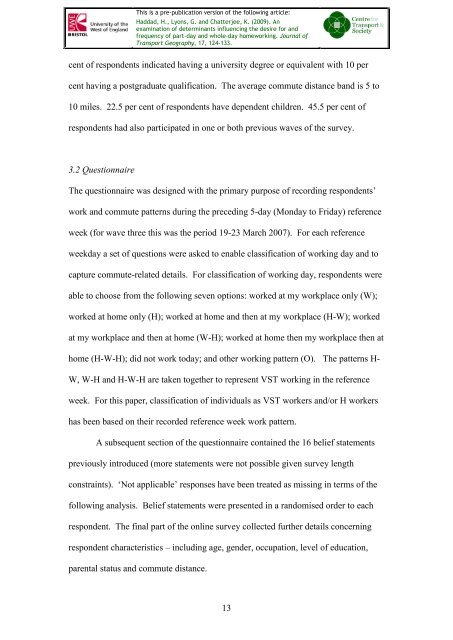Haddad, H. , Lyons, G. and Chatterjee, K. (2009) - UWE Research ...
Haddad, H. , Lyons, G. and Chatterjee, K. (2009) - UWE Research ...
Haddad, H. , Lyons, G. and Chatterjee, K. (2009) - UWE Research ...
You also want an ePaper? Increase the reach of your titles
YUMPU automatically turns print PDFs into web optimized ePapers that Google loves.
This is a pre-publication version of the following article:<br />
<strong>Haddad</strong>, H., <strong>Lyons</strong>, G. <strong>and</strong> <strong>Chatterjee</strong>, K. (<strong>2009</strong>). An<br />
examination of determinants influencing the desire for <strong>and</strong><br />
frequency of part-day <strong>and</strong> whole-day homeworking. Journal of<br />
Transport Geography, 17, 124-133.<br />
cent of respondents indicated having a university degree or equivalent with 10 per<br />
cent having a postgraduate qualification. The average commute distance b<strong>and</strong> is 5 to<br />
10 miles. 22.5 per cent of respondents have dependent children. 45.5 per cent of<br />
respondents had also participated in one or both previous waves of the survey.<br />
3.2 Questionnaire<br />
The questionnaire was designed with the primary purpose of recording respondents‟<br />
work <strong>and</strong> commute patterns during the preceding 5-day (Monday to Friday) reference<br />
week (for wave three this was the period 19-23 March 2007). For each reference<br />
weekday a set of questions were asked to enable classification of working day <strong>and</strong> to<br />
capture commute-related details. For classification of working day, respondents were<br />
able to choose from the following seven options: worked at my workplace only (W);<br />
worked at home only (H); worked at home <strong>and</strong> then at my workplace (H-W); worked<br />
at my workplace <strong>and</strong> then at home (W-H); worked at home then my workplace then at<br />
home (H-W-H); did not work today; <strong>and</strong> other working pattern (O). The patterns H-<br />
W, W-H <strong>and</strong> H-W-H are taken together to represent VST working in the reference<br />
week. For this paper, classification of individuals as VST workers <strong>and</strong>/or H workers<br />
has been based on their recorded reference week work pattern.<br />
A subsequent section of the questionnaire contained the 16 belief statements<br />
previously introduced (more statements were not possible given survey length<br />
constraints). „Not applicable‟ responses have been treated as missing in terms of the<br />
following analysis. Belief statements were presented in a r<strong>and</strong>omised order to each<br />
respondent. The final part of the online survey collected further details concerning<br />
respondent characteristics – including age, gender, occupation, level of education,<br />
parental status <strong>and</strong> commute distance.<br />
13

















